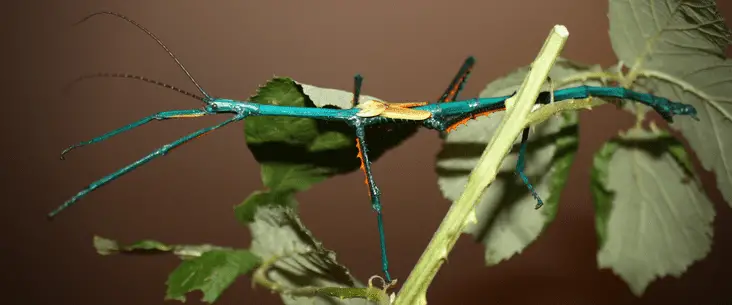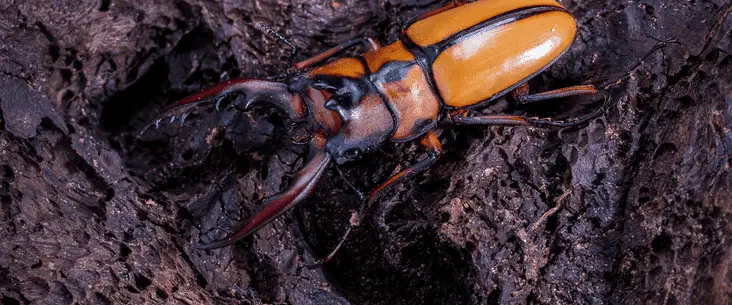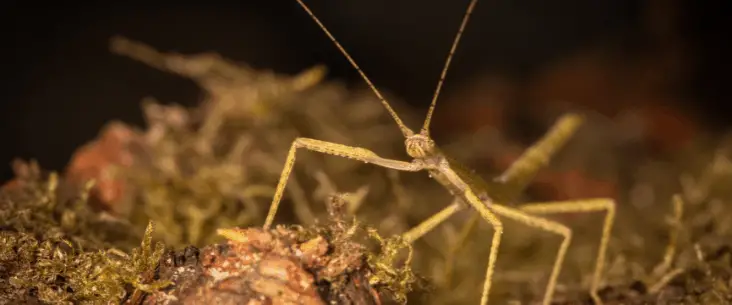Want to start keeping bumblebee millipedes? That’s a great choice! Bumblebee millipedes are beautiful millipedes to keep, and easy and fun to care for. This very popular millipede is one that makes the perfect choice for beginners or a fantastic pet for kids.
To give you and your millipede the perfect start we created this complete care guide. Although the care for bumblebee millipedes are quite easy, there are some essentials you need to provide.
In this bumblebee millipede care guide, we discuss topics about the housing and enclosure requirements, how to create the perfect environmental conditions for your millipede, the best way to feed your millipede and cleaning the habitat. We also look at how you can breed your own baby millipedes in the future.
But first, let’s have a closer look at bumblebee millipedes and discover more about this stunning coloured species.
About the bumblebee millipede
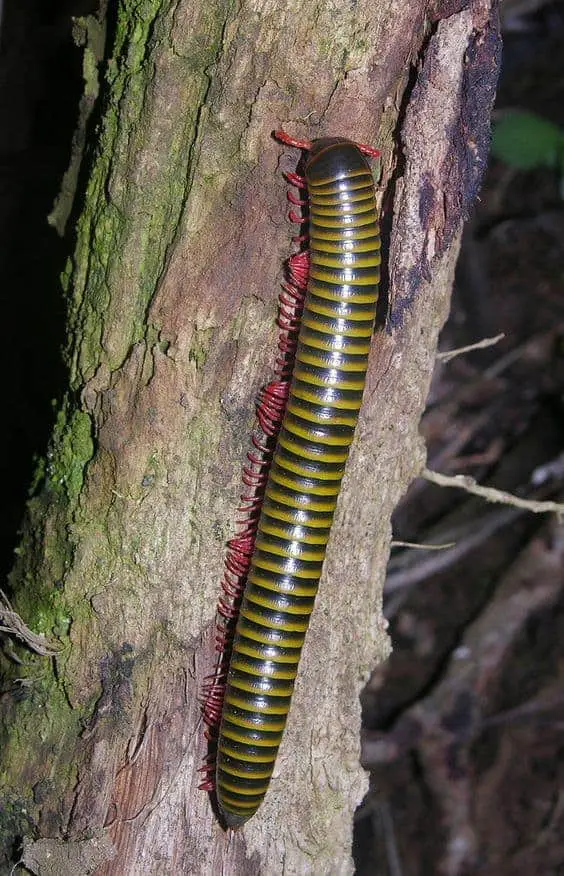
Appearance
Bumblebee millipedes (Anadenobolus monilicornis) are one of the more coloured of all millipedes. Every thick-bodied segment is black/brown with a bright yellow band. They have typical 2 pairs of legs per body segment which are bright red/pink coloured. Also, the antennae are the same colour as their feet.
There are reports of them growing a body size up to 10cm (4″), but most will be around 7.5cm (3″).
Behaviour, temperament and handling
Bumblebee millipedes are not dangerous, don’t bite and are pretty harmless to humans. However, remember that a millipede can secrete toxic and irritating fluids when feeling threatened.
They are slow-moving and very calm animals. They are docile and can be handled when careful. Because of the secretion of irritating fluids, you should always wash your hands after handle them, or wear plastic gloves. Also, when they fall can damage your millipede, which can eventually cause them to die.
Although you can handle them without posing a danger, you should consider that they do not like to be picked up or touched. Often you see millipedes curl up to protect themself from any harm or danger. This behaviour is a sign of stress, so make sure you don’t pick them up or (need to) handle them too often.
Bumblebee millipedes seem to be attracted to light and are quite often above ground wandering around. However, sometimes they like to bury themselves and particularly do that when they are ready to moult. Do not dig them up because this is very stressful for them and you can damage your millipede when moulting or when they just have been moulted (and their exoskeleton still needs to harden).
Housing requirements for bumblebee millipedes
The first step of keeping bumblebee millipedes is to have good housing. The millipede(s) should be in a proper sized enclosure to eventually create a good habitat for your animals. We will discuss it all in this section.
Type and size of the enclosure
Bumblebee millipedes don’t have high enclosure requirements and are quite easy to house. Recommended minimum enclosure size that is at least three times the body size in width and one and a half up to two times the body size in depth. The floor space is more important than height.
Height should be at least one time the body size, but for ease of care, it is recommended to have a bit higher enclosure (also because of the substrate layer).
Millipedes can be housed individually and in groups. When keeping them in groups, you should consider a larger enclosure. Also, be aware that millipedes primarily feed on the substrate, so a larger enclosure is beneficial.
You could use different types and different brands of enclosures. You have some great terrariums from Exo Terra and ReptiZoo that work really well for millipedes. But you can also use an (old) aquarium. A terrarium that I particularly like to keep in millipedes is the Exo Terra Large/Low PT2611. With its size of 90cm x 45cm x 30cm creates enough floor space to house a nice group of millipedes (between 4 and 8 adults). Besides that, it has all the essential features you need to keep and care for millipedes: enough ventilation and doors as well a lid for easy access.
Essential features of the enclosure
There is a myriad of terrarium types that can be used for bumblebee millipedes. But some essential features are required or make keeping them very practical.
The first feature you really need to look out for is ventilation capacity. The enclosure needs to have enough ventilation. Many terrariums have ventilation holes in the front panel and top panel/lid. Basically, that is enough. If you buy an aquarium with a lid, there is not enough ventilation, and you probably need to customize it somewhat (drill holes in the lid or cover it with a metal mesh screen).
The floor should be waterproof so that the moist substrate don’t dry out that fast or that substrate fall out of the enclosure. Net cages are therefore not suitable for keeping millipedes.
Another feature is that the doors are not all the way to the bottom, but there is a front of around 10cm (4″) so that you can hold enough of the substrate in the enclosure when opening the doors.
You need to have easy access. Although doors in front are easy sometimes, it is also recommended to have access from the top of the enclosure (for spraying water or redecorating the enclosure).

The substrate for bumblebee millipedes
The substrate is life for millipedes. You can’t keep millipedes without a good layer of a quality substrate. The substrate of millipedes should be at least 5cm (2″), but better would be to have a depth of 10cm (4″), and consists of two parts: the base component and the food component.
The base component is to create enough volume of a substrate. The best product to use for this purpose is coconut fibre. Besides it is a cheap, clean and consistent product, it also helps to keep up the humidity in the enclosure. You could use other products like potting soil, but in my experience coconut fibre works best (sometimes also called coil fibre, coco fibre or eco earth).
The second part is the food component, which is rather essential for keeping (and breeding) bumblebee millipedes. Millipedes are detritivores, which means they eat primarily on decaying plant matters. So we should provide that as well to keep them healthy. You can use different materials for that, such as leaf litter (from hardwood), pieces of rotten wood (from hardwood), compost soil, or organic compost material from the shop.
Be aware that everything you buy from shops that is not primarily made for animals can hold chemicals and other substances that are deadly for your millipedes. Always check the description or talk to the shop seller for advice if chemicals are added to the products.
How better the quality of your substrate, the healthier your millipedes will be, and with breeding let you have better results and more healthy baby millipedes. You may say that the substrate is the most important part of keeping your millipedes.
Suggested read: Want to know more about the best substrate for millipedes? I wrote an article all about why substrate is so important for millipede and how you can make the best substrate for them that I highly encourage you to read! The substrate can make a real difference for your millipede’s health and happiness.
Environmental conditions wherein to keep bumblebee millipedes
You need to provide a proper climate to keep in your millipedes. Although they don’t have high requirements, still they thrive best when you optimize the temperature and humidity.
About temperature and heating
Bumblebee millipedes should best be kept a bit higher than room temperature, around 22°C up to 28°C (71°F-82°F). Try to keep them in the middle of the temperature range. Try to avoid temperatures above 30°C (86°F) and below 20°C (68°F). Outside the temperature range, the millipede will not feel happy and, when kept in suboptimal temperatures for longer periods, may result in the death of your millipedes.
When you keep them in a room that has a lower ambient temperature, you’ll need additional heating. The best way to achieve this is the use of a regular 30W to 45W light bulb. Another way to go is the use of a low wattage heating pad. This heating pad is best to be placed below the enclosure but can also be taped on the back of the enclosure.
About lighting
All species of millipedes do need a normal light cycle. Not all millipedes directly like light, but this species seems to be attracted by light. Although this fact, you should never place the enclosure in direct sunlight. A glass terrarium can quickly heat up in sunlight up to temperatures deathly to your millipede.
About humidity and spraying
It is important to keep the substrate moist at all times. Humidity is an essential aspect of keeping bumblebee millipedes healthy and happy. You can mist-spraying some (chlorine-free!) water into the enclosure, mostly to moisten the substrate. After spraying, let the top layer of the substrate dry out, before spraying again.
How frequently you need to spray depends on the ventilation and airflow, the ambient humidity of the room and the temperature/heating on the enclosure. Spraying frequency will often range from daily to once a week.
Millipedes drink from the moist substrate and the little water drops on plants, moss or other objects. You don’t need to provide a water bowl. A water bowl can even cause newborn millipedes to drown. Never let the whole substrate dry out. Millipedes are dependent on some moist substrate, and especially the eggs and newly hatched millipedes won’t survive with enough moist substrate.
Be aware that heating of the enclosure causes the substrate (and environment) to dry out quicker. You often need to spray more water or more frequently, but another way is to place the light bulb or heating pad on one half of the enclosure.

Feeding practice
Millipedes can solely survive on the substrate when this is of optimal quality. We already discussed earlier what is needed for the (food) substrate. However, it is good practice to provide supplemental food items as well. Millipedes grow faster and better reproduce when providing supplemental food items. And what’s more, feeding millipedes is fun to do and enjoyable to observe how they mulch these fruits and vegetables.
Supplemental food items
There are multiple food items suitable to feed to these yellow-banded millipedes. Products that you can feed include:
- Fruits such as watermelon, cantaloupe, apples, pears, oranges and pumpkin.
- Vegetables such as cucumber, endive, chicory, carrots, celery and tomatoes.
- Dry dog or cat food pellets.
- Powdered food such as powdered milk, baby powder formula and powdered calcium supplement.
Be aware, not all products are accepted evenly well, and some individuals favour one product over the other. You’ll need to experiment with which products are liked and which are not. Watermelon, cantaloupe, pumpkin and cucumber seem to be eaten by most millipede species.
Method, amount and frequency of feeding
Fruits and vegetables can just be placed on the substrate. There is no need to place them in a food bowl of some sort. This way burrowed, smaller millipedes can also access this food source easily.
Contrary, dog and cat food pellets should better be placed in a food bowl. The reason for this is two-folded:
- When spraying the enclosure water will accumulate in the food bowl and absorbed by the pellets, which makes it easier to eat and provide water to hydrate your millipedes.
- You can more easily clean and refresh the pellets and therefore keep your substrate clean and fresh longer.
The amount you need to feed depends on the number of millipedes in your enclosure and in which life stage therein (or how old they are). Just place some food in the enclosure. As soon as it is all eaten, you can replace it with new food, or at least after three days refresh the food items.
Powdered food should be provided in moderation. You can feed powdered food products once every one or two months. You can sprinkle some powder on the substrate and spray some water on it.
Cleaning routine
One of the reasons bumblebee millipedes are easy pets is because their enclosure does not have to be cleaned that often. Actually, the only thing you need to do is to remove uneaten food items after at least three days or do some spot cleaning when mould/dirt develops.
Once a while (around once every three months or so) you could clean the windows with a wet cloth or paper towel and refresh a dirty part of the substrate with some new food substrate. It is also good practice to add some new rotten wood or leaves from hardwood tree species to the exhibit as a primary food source for your millipede.
Don’t clean the substrate too often. Digging out the substrate, and with that, digging out the (young) millipedes, will unnecessary disturbs them. Too much disturbance will stress or harm your millipedes, especially when a millipede has just moulted or millipede that is just hatched from an egg.
Caution! Be careful with the use of any soap or chemicals to clean the enclosure. Anthropods, where millipedes belong to, can’t handle household cleaning chemicals. When using this soap, can sooner or later kill your millipede. Try to clean the closer only by using water.
When soap is needed, remove the millipede and place them in a temporary enclosure. Make sure afterwards you rinse the soap residue thoroughly with water.
Bumblebee millipedes practical breeding tips
Keeping this stunning millipede species is already an enjoyment, but breeding with them is awesome to achieve. Bumblebee millipedes are not that difficult to breed (although there are some reports that it can be some challenge).
First of all, you need two millipedes, one a male and one a female, obviously. And even when this sounds obvious, it is not always easy to determine which one are males and which one are female. When you wish to breed, it would be easier to keep 4 to 6 individuals to increase the chance you will have both sexes.
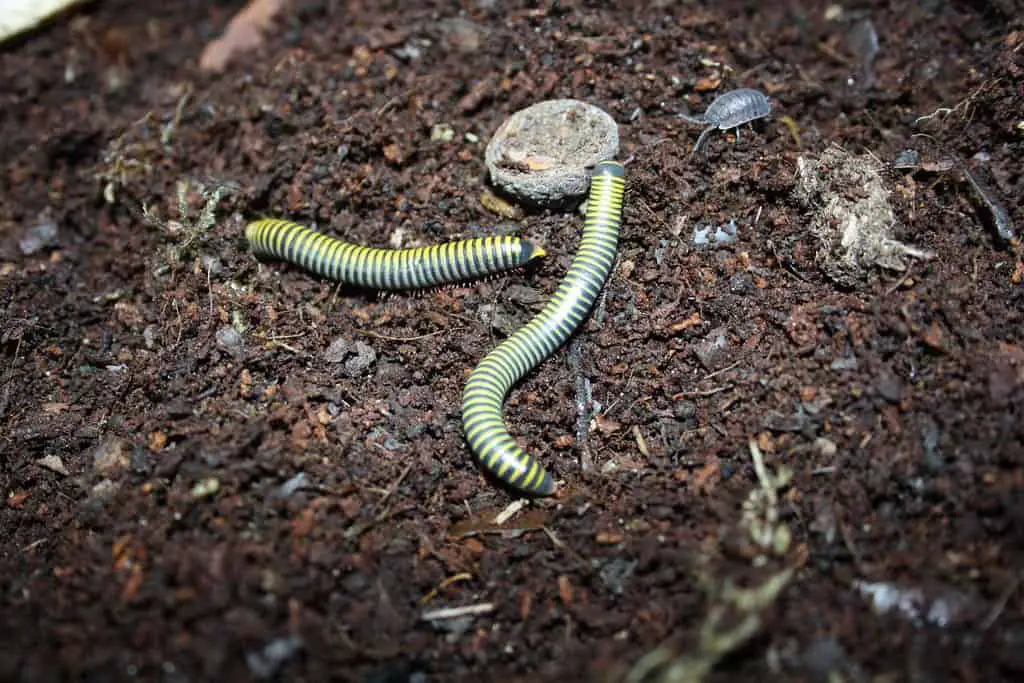
An easy method to tell a male from a female millipede
- The difference between male and female millipede is visible around the moment the millipede is ⅓ of its adult size.
- Place the millipede in a clear container that can be viewed from below.
- Male millipedes can be recognized by the so-called gonopods — the reproductive organs in males. Depending on the species, they typically are on the third or seventh body segment. The gonopods are small and stumpy appendages on the place where normally the legs are attached. In the absence, there should be at least a gap between the regular legs where the gonopods should be.
- Female millipedes lack these gonopods and have normal legs on every body segment. With other words, each body segment should look the same. There is also no gap like there is at males where the gonopods are not visible.
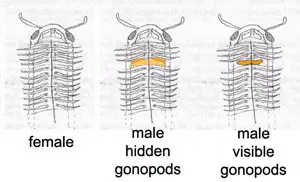
How to stimulate breeding
Breeding bumblebee millipedes is relatively easy. When you have both genders and both are mature, and you keep and care for them properly, you likely will find young millipedes soon. However, there are some things you could or should check to stimulate breeding.
- The substrate should be of good quality, consist of fine material (like coconut fibre) and contain enough decaying organic material as food.
- The substrate needs to have a minimum depth of 8cm (3″), but more would be better (around 15cm (6″). A shallow substrate may prevent the laying of eggs.
- The substrate needs to be pretty damp (however not soaking wet). A substrate that is too dry prevents females from laying eggs and/or laid eggs will die off.
- You can add an additional layer or rotten leaves on top of the substrate. Please don’t mix it in the substrate, because this will disturb the millipedes that are burrowed, moulted or the possible eggs/newly hatched millipedes already in the substrate.
Additional recommended read
Do you want to know more about keeping millipedes? Some additional information on the general care of millipedes can be found in this article.
Are you curious how much it cost to keep millipedes as a pet? We have made a breakdown of the initial and yearly costs of keeping millipedes.
Share this page!

